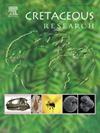来自西德克萨斯州上白垩世Aguja组(下坎帕尼亚)的软骨鱼动物群中的新鲨鱼支持西部内陆软骨鱼动物之间的生物地理隔离
IF 1.7
3区 地球科学
Q1 GEOLOGY
引用次数: 0
摘要
本文报道了一种以口腔牙齿为基础的新软骨鱼类区系,共包括16种,其中Lonchidion conrugis sp. 11和Restesia corricki sp. 11为首次报道。目前的工作补充了之前对其他脊椎动物群体的描述,这些群体来自西德克萨斯州Aguja组的Abajo页岩成员的早期坎帕尼亚,Lowerverse微化石地区。该动物群聚集在咸淡水潮间带沉积环境中,与上覆阿古加组近岸海相沉积物中发现的准同生10位软骨鱼组合有明显不同。与十比特区系相比,Lowerverse区系的鱼齿鲨和鳍甲双形鲨的多样性和丰度相对较高,而板形鲨的多样性和丰度相对较低。在10位区系中数量最多的鲨鱼(Scapanorhynchus、Squalicorax和Serratolamna)在Lowerverse区系中很少或没有。在Ten Bits区系中,鳐和锯鳐的种类也更丰富,但在Lowerverse区系中最常见的分类群(Cristomylus, Texatrygon)在Ten Bits区系中没有或非常罕见。Lowerverse组合在北美西部内陆存在Restesia的副同世圣东纪-早坎帕纪软骨鱼动物群中是独一无二的。一些分类群(Scapanorhynchus, Rhombodus)只在这些动物群的最南端被发现,而其他分类群(Cantioscyllium, Columbusia, Cristomylus, Ptychotrygon和Texatrygon)只在北部的犹他州被发现。在这段时间里,下游软骨鱼动物群支持西部内陆一些软骨鱼物种的区域分离。本文章由计算机程序翻译,如有差异,请以英文原文为准。
New sharks in a chondrichthyan fauna from the Upper Cretaceous Aguja Formation (lower Campanian) of West Texas support biogeographic segregation among chondrichthyans in the Western Interior
A new, oral tooth-based chondrichthyan fauna consisting of 16 species is reported, two of which, Lonchidion conrugis sp. nov. and Restesia corricki sp. nov. are described for the first time. The present work compliments previous descriptions of other vertebrate groups from the early Campanian, Lowerverse microfossil locality in the Abajo Shale Member of the Aguja Formation of West Texas. This local fauna accumulated in a brackish water intertidal depositional setting, and differs significantly from the paracontemporaneous Ten Bits chondrichthyan assemblage found in overlying nearshore marine deposits of the Aguja Formation. The Lowerverse fauna exhibits a comparatively greater diversity and greater relative abundance of hybodont and orectolobiform sharks, but comparatively lower diversity and lower abundance of lamniform sharks compared to the Ten Bits fauna. The most abundant sharks in the Ten Bits fauna (Scapanorhynchus, Squalicorax, and Serratolamna) are rare or absent in the Lowerverse fauna. Rays and sawfishes are also more diverse and more abundant in the Ten Bits fauna, but the most common taxa in the Lowerverse fauna (Cristomylus, Texatrygon) are absent or very rare at Ten Bits. The Lowerverse assemblage is unique among paracontemporaneous Santonian–early Campanian chondrichthyan faunas in the Western Interior of North America in the presence of Restesia. Several taxa (Scapanorhynchus, Rhombodus) are found only in the southernmost of these faunas, and others (Cantioscyllium, Columbusia, Cristomylus, Ptychotrygon, and Texatrygon) are found only as far north as Utah. The Lowerverse chondrichthyan fauna supports regional segregation of some chondrichthyan species in the Western Interior during this time.
求助全文
通过发布文献求助,成功后即可免费获取论文全文。
去求助
来源期刊

Cretaceous Research
地学-地质学
CiteScore
4.10
自引率
19.00%
发文量
235
审稿时长
12 weeks
期刊介绍:
Cretaceous Research provides a forum for the rapid publication of research on all aspects of the Cretaceous Period, including its boundaries with the Jurassic and Palaeogene. Authoritative papers reporting detailed investigations of Cretaceous stratigraphy and palaeontology, studies of regional geology, and reviews of recently published books are complemented by short communications of significant new findings.
Papers submitted to Cretaceous Research should place the research in a broad context, with emphasis placed towards our better understanding of the Cretaceous, that are therefore of interest to the diverse, international readership of the journal. Full length papers that focus solely on a local theme or area will not be accepted for publication; authors of short communications are encouraged to discuss how their findings are of relevance to the Cretaceous on a broad scale.
Research Areas include:
• Regional geology
• Stratigraphy and palaeontology
• Palaeobiology
• Palaeobiogeography
• Palaeoceanography
• Palaeoclimatology
• Evolutionary Palaeoecology
• Geochronology
• Global events.
 求助内容:
求助内容: 应助结果提醒方式:
应助结果提醒方式:


